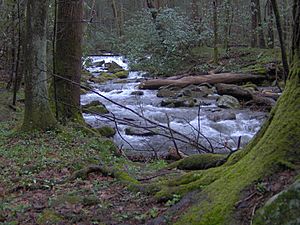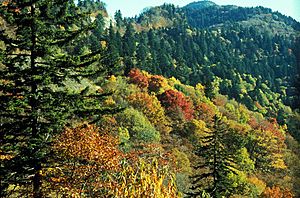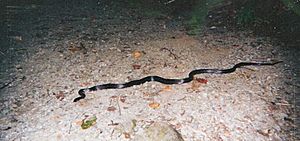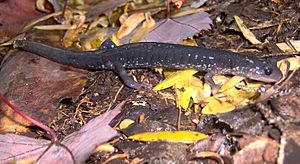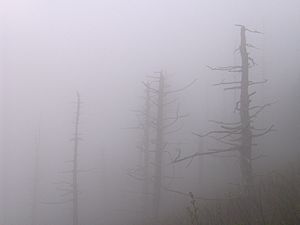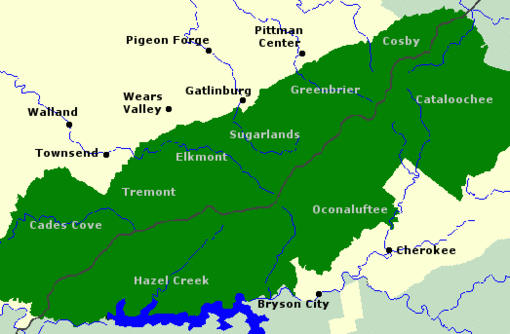Great Smoky Mountains facts for kids
Quick facts for kids Great Smoky Mountains |
|
|---|---|
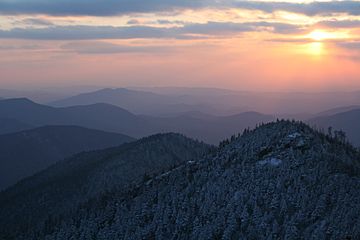
The Smoky Mountains viewed from atop Mount Le Conte in Sevier County, Tennessee, in April 2007
|
|
| Highest point | |
| Peak | Clingmans Dome |
| Elevation | 6,643 ft (2,025 m) |
| Geography | |
| Country | United States |
| Parent range | Blue Ridge Mountains |
| Geology | |
| Orogeny | Alleghanian |
The Great Smoky Mountains are a beautiful mountain range in the southeastern United States. They rise along the border between Tennessee and North Carolina. People often call them the Smoky Mountains or just the Smokies. The name comes from the natural fog that often covers the peaks, making them look like they are smoking!
These mountains are part of the larger Appalachian Mountains. Most of the Smokies are protected by the Great Smoky Mountains National Park. This park was created in 1934. It is the most visited national park in the United States, with over 11 million people visiting each year!
Contents
- Where are the Smoky Mountains?
- Tallest Peaks in the Smokies
- Smoky Mountains Climate
- How the Mountains Formed
- Amazing Plants of the Smokies
- Amazing Animals of the Smokies
- Threats to the Ecosystem
- History of the Smoky Mountains
- Creating the National Park
- Culture and Tourism in the Smokies
- Interesting Facts About the Great Smoky Mountains
- See also
Where are the Smoky Mountains?

The Great Smoky Mountains are located right on the line between Tennessee and North Carolina. They stretch from the Pigeon River in the northeast to the Little Tennessee River in the southeast.
These mountains cover parts of several counties. In Tennessee, they are in Blount, Sevier, and Cocke counties. In North Carolina, they are in Swain and Haywood counties.
Many rivers and streams start high up in the Smokies. Examples include the Little Pigeon River and the Little River. All the water from these streams eventually flows into the Tennessee River.
Tallest Peaks in the Smokies
The highest point in the Smokies is Clingmans Dome. It is the tallest mountain in Tennessee, reaching 6,643 feet (2,025 meters) high.
Another important peak is Mount Le Conte. It rises 5,301 feet (1,616 meters) from its base in Gatlinburg. Its summit is 6,593 feet (2,010 meters) high.
Here are some of the notable mountains in the Smokies:
| Mountain | Elevation | General location | Named after |
|---|---|---|---|
| Clingmans Dome | 6,643 ft/2,025 m | Central Smokies | Thomas Lanier Clingman (1812–1897), surveyor |
| Mount Guyot | 6,621 ft/ 2,018m | Eastern Smokies | Arnold Guyot (1807–1884), surveyor |
| Mount Le Conte | 6,593 ft/2,010 m | Central Smokies | Joseph Le Conte or John Le Conte, scientists |
| Mount Chapman | 6,431 ft/1,960 m | Eastern Smokies | David Chapman (1876–1944), park promoter |
| Old Black | 6,360 ft/1,939 m | Eastern Smokies | Spruce-fir stand at summit |
| Luftee Knob | 6,215 ft/1,894 m | Eastern Smokies | Oconaluftee River |
| Mount Kephart | 6,218 ft/1,895 m | Central Smokies | Horace Kephart (1862–1931), author |
| Mount Collins | 6,197 ft/1,888 m | Central Smokies | Robert Collins, mountain guide |
| Marks Knob | 6,162 ft/1,878 m | Eastern Smokies | |
| Tricorner Knob | 6,145 ft/1,873 m | Eastern Smokies | Intersection of Balsam crest and Great Smokies crest |
| Mount Hardison | 6,145 ft/1,873 m | Eastern Smokies | James Archibald Hardison (1867–1930) |
| Andrews Bald | 5,909 ft/1,801 m | Central Smokies | possibly Andres Thompson, early settler |
| Mount Sterling | 5,842 ft/1,781 m | Eastern Smokies | possibly lead at mountain's base mistaken for silver |
| Silers Bald | 5,597 ft/1,706 m | Western Smokies | Jesse Siler, who used the mountain for grazing |
| Thunderhead Mountain | 5,528 ft/1,684 m | Western Smokies | constant cloud cover |
| Gregory Bald | 4,949 ft/1,508 m | Western Smokies | Russell Gregory (1805–1863), Cades Cove resident |
| Mount Cammerer | 4,928 ft/1,502 m | Eastern Smokies | Arno B. Cammerer (1883–1941), NPS director |
| Chimney Tops | 4,725 ft/1,440m | Central Smokies | resemblance to cabin chimneys |
| Blanket Mountain | 4,607 ft/1,404 m | Western Smokies | blanket left atop mountain by surveyor Return Meigs for a reference point |
| Shuckstack | 4,020 ft/1,225 m | Western Smokies |
Smoky Mountains Climate
The Smoky Mountains get a lot of rain and snow. This is because they are so tall. The amount of rain each year can be 50 to 80 inches (1,300 to 2,000 mm). This is much more than nearby flat areas. Heavy rain can sometimes cause flash flooding.
Snowfall can be very heavy in winter. This is especially true on the higher parts of the mountains.
Temperatures change a lot depending on how high you are. The higher you go, the cooler it gets. For example, it's about 10 to 13°F (-12 to -11°C) cooler at Newfound Gap (5,000 feet high) than at the park headquarters (1,600 feet high).
Sometimes, very strong winds blow through the mountains. These winds can be very powerful, reaching 80 to 100 mph (130 to 160 km/h) or more! They can cause trees to fall.
The climate in the highest parts of the Smokies is like places much further north. The lower areas have a climate more like the rest of the southeastern United States.
| Climate data for Clingmans Dome | |||||||||||||
|---|---|---|---|---|---|---|---|---|---|---|---|---|---|
| Month | Jan | Feb | Mar | Apr | May | Jun | Jul | Aug | Sep | Oct | Nov | Dec | Year |
| Mean daily maximum °F (°C) | 35 (2) |
35 (2) |
39 (4) |
49 (9) |
57 (14) |
63 (17) |
65 (18) |
64 (18) |
60 (16) |
53 (12) |
42 (6) |
37 (3) |
50 (10) |
| Daily mean °F (°C) | 27.0 (−2.8) |
26.5 (−3.1) |
31.5 (−0.3) |
41.5 (5.3) |
50.0 (10.0) |
56.0 (13.3) |
59.0 (15.0) |
58.0 (14.4) |
53.5 (11.9) |
45.5 (7.5) |
35.0 (1.7) |
29.0 (−1.7) |
43.0 (6.1) |
| Mean daily minimum °F (°C) | 19 (−7) |
18 (−8) |
24 (−4) |
34 (1) |
43 (6) |
49 (9) |
53 (12) |
52 (11) |
47 (8) |
38 (3) |
28 (−2) |
21 (−6) |
36 (2) |
| Average precipitation inches (mm) | 7.0 (180) |
8.2 (210) |
8.2 (210) |
6.5 (170) |
6.0 (150) |
6.9 (180) |
8.3 (210) |
6.8 (170) |
5.1 (130) |
5.4 (140) |
6.4 (160) |
7.3 (190) |
82.1 (2,100) |
| Average snowfall inches (cm) | 18 (46) |
20 (51) |
26 (66) |
5 (13) |
trace | 0 (0) |
0 (0) |
0 (0) |
trace | 2 (5.1) |
5 (13) |
8 (20) |
84 (214.1) |
| Climate data for Gatlinburg, Tennessee | |||||||||||||
|---|---|---|---|---|---|---|---|---|---|---|---|---|---|
| Month | Jan | Feb | Mar | Apr | May | Jun | Jul | Aug | Sep | Oct | Nov | Dec | Year |
| Mean daily maximum °F (°C) | 51 (11) |
54 (12) |
61 (16) |
71 (22) |
79 (26) |
86 (30) |
88 (31) |
87 (31) |
83 (28) |
73 (23) |
61 (16) |
52 (11) |
71 (22) |
| Daily mean °F (°C) | 39.5 (4.2) |
41.5 (5.3) |
47.5 (8.6) |
56.5 (13.6) |
64.5 (18.1) |
72.0 (22.2) |
73.5 (23.1) |
73.5 (23.1) |
69.0 (20.6) |
58.0 (14.4) |
47.0 (8.3) |
40.0 (4.4) |
57.0 (13.9) |
| Mean daily minimum °F (°C) | 28 (−2) |
29 (−2) |
34 (1) |
42 (6) |
50 (10) |
58 (14) |
59 (15) |
60 (16) |
55 (13) |
43 (6) |
33 (1) |
28 (−2) |
43 (6) |
| Average precipitation inches (mm) | 4.8 (120) |
4.8 (120) |
5.3 (130) |
4.5 (110) |
4.5 (110) |
5.2 (130) |
5.7 (140) |
5.3 (130) |
3.0 (76) |
3.1 (79) |
3.4 (86) |
4.5 (110) |
54.1 (1,341) |
| Average snowfall inches (cm) | 2.3 (5.8) |
2.9 (7.4) |
trace | 0 (0) |
0 (0) |
0 (0) |
0 (0) |
0 (0) |
0 (0) |
trace | 0.7 (1.8) |
1.0 (2.5) |
6.9 (17.5) |
How the Mountains Formed

Most of the rocks in the Great Smoky Mountains are very, very old. They are part of something called the Ocoee Supergroup. These rocks formed over a billion years ago from layers of sand and mud.
Even older rocks, like gneiss and granite, are found in some areas. These rocks formed from ancient oceans and volcanic activity.
Millions of years ago, the land that is now North America and Africa slowly crashed together. This huge collision pushed and folded the rocks. This created the Appalachian Mountains, including the Smokies. Over a very long time, softer rocks wore away. This left the harder, older rocks that make up the mountains today.
About 20,000 years ago, during the last ice age, the weather here became much colder. This cold weather changed the types of plants that grew. It also helped shape the landscape we see today.
Amazing Plants of the Smokies

The Great Smoky Mountains are famous for having an incredible variety of plants. There are about 187,000 acres (760 square kilometers) of old-growth forest left. This is the largest area of old forest in the eastern United States!
You can find over 1,600 different kinds of flowering plants here. This includes more than 100 types of trees and 100 types of shrubs. There are also over 450 types of non-flowering plants like mosses and ferns. Plus, there are 2,000 types of fungi!
The forests in the Smokies are usually divided into three main types based on how high up they are:
- Cove Hardwood Forests: These are in lower areas like valleys. They have the most different kinds of trees. You can find trees like yellow birch, tulip trees, and sugar maples here.
- Northern Hardwood Forests: As you go higher, the weather gets cooler. These forests are mostly made of yellow birch and American beech trees.
- Spruce-Fir Forests: At the very highest, coldest elevations, you find forests like those in Canada. These are mostly red spruce and Fraser fir trees.
You can also find open areas called "balds" where trees don't grow well. Some are covered in thick grasses, and others have dense bushes like rhododendron.
Wildflowers in the Mountains
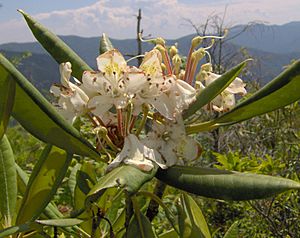
Many beautiful wildflowers grow in the mountains and valleys. These include bee balm, Solomon's seal, Dutchman's breeches, and various trilliums. You can even find hardy orchids.
There are two native types of rhododendron. The catawba rhododendron has purple flowers in May and June. The rosebay rhododendron has white or light pink blooms in June and July.
Amazing Animals of the Smokies

The Great Smoky Mountains are home to a huge variety of animals! There are 66 different kinds of mammals. You can also find over 240 types of birds. There are 43 types of amphibians, like frogs and salamanders. Plus, there are 60 types of fish and 40 types of reptiles, like snakes and turtles.
Black Bears
One of the most famous animals in the Smokies is the black bear. The Smokies have the largest population of black bears in the eastern United States! These bears have become a symbol of the park. Most adult black bears here weigh between 100 and 300 pounds (45 to 136 kg). Some can grow to be over 500 pounds (230 kg)!
Other Mammals
Besides bears, you can see white-tailed deer. Bobcats are the only wild cats still living here. Coyotes have also moved into the area. You can also find red foxes and gray foxes.
European boars were brought here a long time ago for hunting. They are now considered a problem because they damage plants. They also compete with bears for food.
The Smokies are home to many small mammals too, like squirrels and bats. The park has also successfully brought back river otters and elk to the area.
Birds
With so many different types of forests, the Smokies are a great place for birds. You can find birds that like warmer climates in the lower forests. Birds that prefer cooler weather live in the higher forests. Some common birds include wild turkeys and hummingbirds. You might even spot bald eagles or golden eagles flying overhead!
Reptiles and Amphibians
The Smokies have two types of venomous snakes: the timber rattlesnake and the copperhead. They are usually found in different areas of the park. You can also see turtles, lizards, and non-venomous snakes.
The Smokies are especially famous for their salamanders. They have one of the most diverse salamander populations in the world! There are up to 31 different kinds of salamanders here. Some are found only in the Smokies or nearby mountains.
Fish
The streams in the Smokies are home to various fish. These include trout, bass, and darters. The brook trout is the only type of trout that is originally from these mountains. Other types, like rainbow trout and brown trout, were brought here later.
Threats to the Ecosystem
Air pollution is harming red spruce trees at higher elevations. It is also causing oak trees to decline at lower elevations. Invasive insects like hemlock woolly adelgids attack hemlocks. Balsam woolly adelgids attack Fraser firs. Scientists have introduced a type of ladybug beetle, Pseudoscymnus tsugae, to try and control these pests.
Visibility is greatly reduced by smog. This smog comes from both the Southeastern and Midwestern United States. The Environmental Protection Agency provides daily smog forecasts for nearby cities.
Many groups work to protect the Smokies. The Friends of the Smokies group helps the National Park Service. They raise money and public awareness. They also provide volunteers for important projects.
History of the Smoky Mountains

People have lived in and used the Great Smoky Mountains for a very long time.
Early People and the Cherokee
Native Americans were hunting in these mountains as far back as 14,000 years ago! Scientists have found old tools and items they left behind. Later, Native Americans started farming more. They built villages in the river valleys around the mountains.
By the time Europeans arrived, the Cherokee people were living in and around the Great Smoky Mountains. The mountains were a very important part of their land and their stories. The Cherokee had names for many places, like Kuwohi, which means "mulberry place."
Most Cherokee villages were in the valleys. One known village within what is now the national park was called Oconaluftee.
European Settlers Arrive
European explorers and settlers started coming to the area in the mid-1700s. As more settlers arrived, there were conflicts with the Cherokee over the land. After the American Revolution, the Cherokee gave up control of the Smokies to the U.S. government.
Many Cherokee were later forced to move west on the "Trail of Tears." However, some were able to stay on land that is now the Qualla Boundary. They are known today as the Eastern Band of Cherokee Indians.
Settlers began building homes in the valleys of the Smokies in the late 1700s and early 1800s. Families like the Ogles helped start the town that became Gatlinburg. The Olivers were the first settlers in Cades Cove. Life was focused on farming, family, and churches.
The Civil War Era
During the American Civil War (1861-1865), people in the Smoky Mountains had different feelings. Generally, people on the Tennessee side supported the Union (the North). People on the North Carolina side supported the Confederacy (the South).
There were no big battles in the Smokies. But there were smaller fights and conflicts between groups supporting different sides.
Logging the Forests
For a long time, it was hard to cut down trees in the steep Smoky Mountains. But in the late 1800s and early 1900s, new technology changed this. Logging railroads and better saws made it possible to cut down large areas of the forest.
Big logging companies moved into the Smokies. They cut down trees for many years. They even built towns for their workers, like Townsend and Elkmont. By the 1930s, about two-thirds of the original forests had been cut down.
Creating the National Park
As the forests were being cut down, some people realized how special the Smoky Mountains were. They wanted to protect them. In the early 1920s, people started working to create a national park.
Creating the Great Smoky Mountains National Park was a big job. The land was owned by many different people and logging companies. People had to raise money to buy the land from thousands of small farmers. They also had to convince logging companies to sell their rights to cut down trees. Entire communities had to move.
Thanks to the hard work of many people, most of the land was bought by 1932. The Great Smoky Mountains National Park officially opened in 1934. President Franklin D. Roosevelt spoke at the opening ceremony.
Culture and Tourism in the Smokies
The culture around the Great Smoky Mountains is deeply connected to the history of southern Appalachia and the Cherokee people.
Today, tourism is very important to the towns near the park. These towns include Pigeon Forge, Gatlinburg, and Cherokee. Millions of people visit the park each year. They come to see the beautiful scenery, hike the trails, and learn about the area's history and nature.
The Great Smoky Mountains National Park is the most visited national park in the United States!
One popular attraction is the Gatlinburg SkyLift and SkyBridge. The SkyBridge is the longest pedestrian suspension bridge in the United States. It stretches about 680 feet long!
The Great Smoky Mountains are also recognized internationally. They are an International Biosphere Reserve and a UNESCO World Heritage Site. This is because of their unique natural importance.
Interesting Facts About the Great Smoky Mountains
- The mountains get their name from the natural fog that often covers them. This fog makes them look like they are covered in smoke.
- The Smokies are home to one of the world's most diverse salamander populations.
- The tallest mountain in the Smokies is called Kuwohi. It reaches up to 6,643 feet (2,025 meters) high. It is the tallest mountain in all of Tennessee!
- The Great Smoky Mountains are home to The Gatlinburg SkyLift and SkyBridge. The SkyBridge is the longest skybridge in the United States, at about 680 feet long.
- The only two venomous snake species in the Smokies are the Timber rattlesnake and the copperhead.
- A really cool natural event happens in the Smokies in mid-June. A type of firefly called Photinus carolinus flashes its lights all at the same time! This synchronized flashing is a rare sight. It happens in a few places in the park, especially near Elkmont, Tennessee.
See also
 In Spanish: Montañas Great Smoky para niños
In Spanish: Montañas Great Smoky para niños




